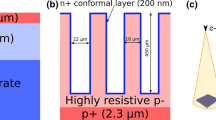Abstract
The study discusses the prospects for the development of low-voltage power supply sources. Beta isotope sources present great advantages for autonomous uninterrupted operation of remote devices, which gives an impulse to rapid development of betavoltaics. Silicon carbide homo- and hetero-structures serve as the isotope-based energy converters. We propose a new technology for isotope-based converter fabrication using silicon carbide and carbon-14 heterostructure as the active substance.
Similar content being viewed by others
References
P. I. Rappaport, J. J. Loferski, and E. G. Lindery, “A study program of possible uses new principle”, Nucleonics 15, 99 (1957).
L. C. Olsen, S. E. Seeman, and B. I. Griffen “Betavoltaic nuclear electric power sources”, Trans. Electron. Devices 2, 481 (1969).
V. V. Gusev, “Specific features of transformation of radioactive decay energy into electric energy using p-n silicon semiconductors”, in V. V. Gusev, V. M. Kodyukov, A. A. Pochtakov, A. A. Pustovalov, Eds., Radiatsionnaya Tekhnika (Radiation Technology), vol. 11, 61–67 (1975) [in Russian].
Yu. V. Lazarenko, A. A. Pustovalov, V. P. Napovalov “Small-Size Nuclear Sources of Electric Energy” (Energoatomizdat, Moscow, 1992) [in Russian].
RF Patent N 2461915 MPK.H01L31/04. “Nuclear Battery”.
RF Patent N 2452060 MPK.H01L31/04 G01H 1/00. “Semiconductor beta radiation to electric energy converter”.
US Patent No. 8866245. “Nuclear batteries”.
US Patent No. 8802456. “Betavoltaic battery with a shallow junction and a method for making same”.
US Patent No. 8487392. “High power density betavoltaic battery”.
US Patent No. 20110291210. “Betavoltaic power converter die stacking”.
US Patent No. 20120186637. “High-energy beta-particle source for betavoltaic power converter”.
A. A. Reznev et al., “Prospects of development of a miniature current source based on betavoltaic effect using nickel-63 isotope as an active element”, Nano Micro Syst. Technol. 3, 14–16 (2009).
Yu. S. Nagornov, “Calculation of efficiency of power supply elements based on microchannel silicon and nickel-63 beta source”, Izv. Vyssh. Uchebn. Zaved. Povolzhsk. Reg. Fiz.-Mat. Nauki 3 (27), 136–145 (2013).
Yu. S. Nagornov, “Modern Aspects of Betavoltaic Effect Application” (UlGPU, Ul’yanovsk, 2012) 113 p. [in Russian].
C. J. Eiting, V. Krishnamoorthy, S. Rodgers, “Demonstration of radiation resistant, high efficiency SiC betavoltaic”, Appl. Phys. Lett. 88, 064101-1-064101-3 (2006).
V. B. Anufrienko et al. “Applilcation of supermultilayered nanostructures for direct conversion of nuclear energy into electric energy”, Nano Micro Syst. Technol. 8, 30–38 (2008).
http://www.citylabs.net.
www.betabatt.com.
S-K. Lee et al., “Development of nuclear micro-battery with solid tritium source”, Appl. Radiat. Isotopes 67(7-8), 1234–1238 (2009).
B. K. Liu et al. “Betavoltaics using scandium tritide and contact potential difference”, Appl. Phys. Lett. 92, 083511-1-083511-3 (2008).
B. K. Liu et al., “Tritium locked in silica using 248 nm KrF laser irradiation”, Appl. Phys. Lett. 88, 134101 (2006).
RF Patent RU N 2084979 MKI.6 G21G1/06. “A method for extracting Carbon-14 radionuclide from neutron-irradiated aluminum nitride”.
RF Patent RU N 2172533 MPK. G21G1/06. “A method for obtaining carbon-14 radionuclide”.
V. Luchinin and Yu. Tairov, “Domestic semiconductor silicon carbide: A step toward parity”, Sovr. Elektron. 7, 4 (2009).
J. A. Lely, “Darstellung von Einkristallen von Siliciumcarbid und Beherschung von Art und menge Eingebauten Verunreinigungen”, Ber. Dt. Keram. 32, 229 (1955).
A. A. Kal’nin, V. V. Luchinin, F. Noibert, and Yu.M. Tairov, “Regularity of evolution of a crystalline structure in synthesis of substances with many structure-stable states”, Zh. Tekh. Fiz. 54 (7), 1388–1390 (1984).
Yu. M. Tairov and V. F. Tsvetkov, “Investigation of growth processes of ingots of silicon carbide single crystals”, J. Cryst. Growth 43, 209 (1978).
M. J. Hernander, “Study of surface defects on 3C-SiC film grown on Si (III) by CVD”, J. Cryst. Growth 253, 95–101 (2003).
A. S. Zubrilov, “Electric properties of hetero-transitions 3C-SiC/Si”, Semiconductors 28(10) 1742–1746 (1994).
C. J. Mogab and H. J. Leamy, “Conversion of epitaxial SiC by reaction with C2H2", J. Appl. Phys. 45(3), 1075–1084 (1974).
A. Addamiano and J. A. Spragye, “Buffer-layer” technique for the growth of single crystal SiC on Si”, J. Appl. Phys. Lett. 44 (1), 525–527 (1974).
RF Patent RU N 2370851 MPK. H01L21/205. “A method of self-organizing endotaxy of mono 3C-SiC on Si substrate”.
A. V. Gurskaya, V. I. Chepurnov, and M. V. Dolgopolov, “Energy converters of C-14 beta decay”, presented at 22 All-Russian Scientific Conference of Student Physicists and Young Scientists, Rostov, April 21–28, 2016, 183.
M. V. Dolgopolov, V. I. Chepurnov, A. V. Gurskaya, S. N. Podgornov, and A. N. Shcherbakov, “Heterostructure por-SiC/Si for applied use”, Int. Conf. “Electronics-2015”, 2015, 13.
Author information
Authors and Affiliations
Corresponding author
Additional information
Original Russian Text © A.V. Gurskaya, M.V. Dolgopolov, V.I. Chepurnov, 2017, published in Fizika Elementarnykh Chastits i Atomnogo Yadra, 2017, Vol. 48, No. 6.
Rights and permissions
About this article
Cite this article
Gurskaya, A.V., Dolgopolov, M.V. & Chepurnov, V.I. C-14 beta converter. Phys. Part. Nuclei 48, 941–944 (2017). https://doi.org/10.1134/S106377961706020X
Published:
Issue Date:
DOI: https://doi.org/10.1134/S106377961706020X




